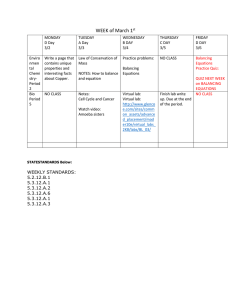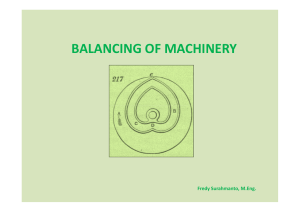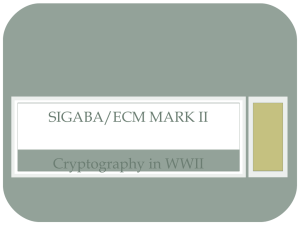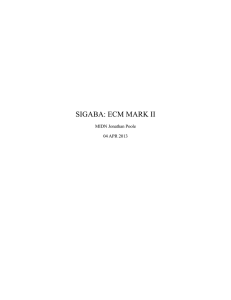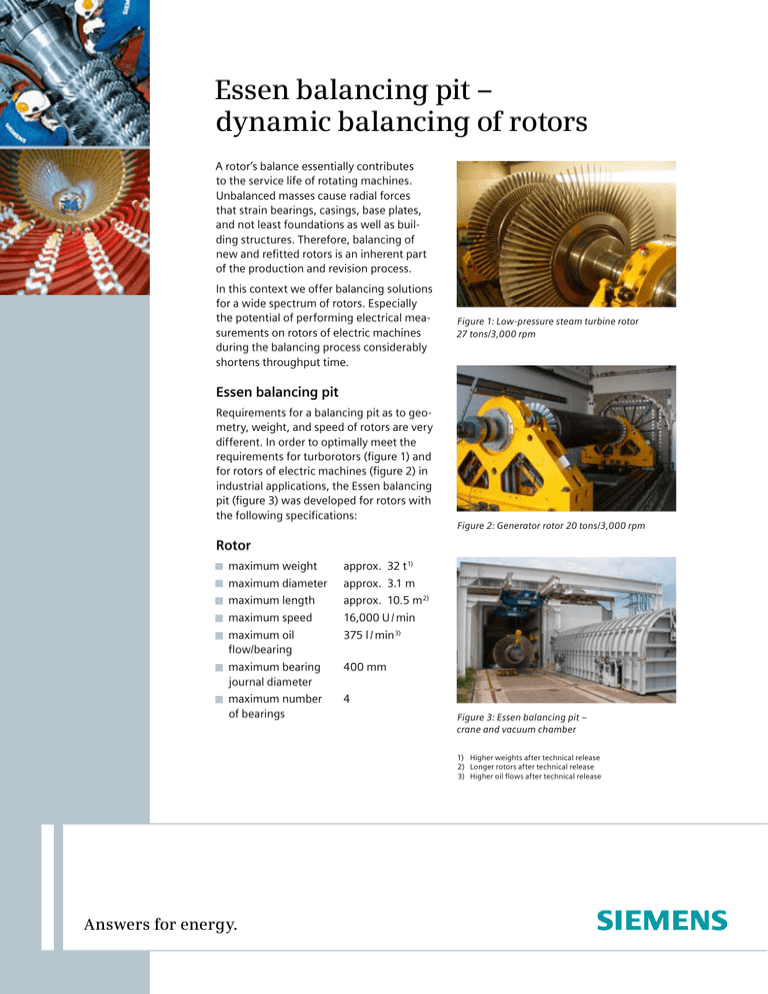
Essen balancing pit –
dynamic balancing of rotors
A rotor’s balance essentially contributes
to the service life of rotating machines.
Unbalanced masses cause radial forces
that strain bearings, casings, base plates,
and not least foundations as well as building structures. Therefore, balancing of
new and refitted rotors is an inherent part
of the production and revision process.
In this context we offer balancing solutions
for a wide spectrum of rotors. Especially
the potential of performing electrical measurements on rotors of electric machines
during the balancing process considerably
shortens throughput time.
Figure 1: Low-pressure steam turbine rotor
27 tons/3,000 rpm
Essen balancing pit
Requirements for a balancing pit as to geometry, weight, and speed of rotors are very
different. In order to optimally meet the
requirements for turborotors (figure 1) and
for rotors of electric machines (figure 2) in
industrial applications, the Essen balancing
pit (figure 3) was developed for rotors with
the following specifications:
Figure 2: Generator rotor 20 tons/3,000 rpm
Rotor
maximum weight
approx. 32 t 1)
maximum diameter
approx. 3.1 m
maximum length
approx. 10.5 m 2)
maximum speed
16,000 U / min
maximum oil
flow/bearing
375 l / min 3)
maximum bearing journal diameter
400 mm
maximum number
of bearings
4
Figure 3: Essen balancing pit –
crane and vacuum chamber
1) Higher weights after technical release
2) Longer rotors after technical release
3) Higher oil flows after technical release
Answers for energy.
Driver unit (figure 4)
DC motor
maximum power/speed
1.35 MW / 1,300 U / min
direction of rotation left/right
gear ratios:
shift gear
transmission
1:1/1:4
turbo gear
transmission
1:3,5
shifting steps:
low-speed
high-speed Figure 4: Driver unit – direct current motor,
shift gear, turbo gear
1:1/1:3.5
0 - 4,550 U / min
1:4 /1:3.5
0 - 16,000 U / min
Main control room
The main control room of the balancing
pit (figure 5) comprises three operator
terminals:
vibration measurements and control
process control
electric measurements
For the vibration measurement the
Schenck-Systems CAB690 and Cabflex++
are used ensuring the following
standards are met:
International
ISO 1940, ISO 11342
Standard Organization
American Petroleum
Institute
Published by and copyright © 2008:
Siemens AG
Energy Sector
Freyeslebenstrasse 1
91058 Erlangen, Germany
Siemens Power Generation, Inc.
4400 Alafaya Trail
Orlando, FL 32826-2399, USA
For more information, contact our
Customer Support Center.
Phone:+49 180/524 70 00
Fax: +49 180/524 24 71
(Charges depending on provider)
e-mail: support.energy@siemens.com
www.siemens.com/energy-support
Order No. A96001-G90-B188-X-4A00
Printed in Germany
1386 J DA 0208 1.
All rights reserved.
Subject to change without prior notice.
Printed on paper treated with chlorinefree bleach.
Trademarks mentioned in this document are the property of Siemens AG,
its affiliates, or their respective owners.
The information in this document
contains general descriptions of the
technical options available, which may
not apply in all cases. The required
technical options should therefore be
specified in the contract.
API 617
In order to simulate realistic conditions,
balancing at operating temperature
may be carried out for rotors of electric
machines by means of electric heating.
For a final inspection, documents of
frequency analyses,
amplitude/phase diagrams,
shaft vibration measurements
are compiled in accordance with the
respective guidelines.
Figure 5: Main control room – vibration
measurements, process control, electric
measurements (f.l.t.r.)
The interaction of the plant components
(oil system, vacuum system/chamber,
and driver unit) is controlled by a modern
control circuitry system (WINCC) via pointand-click.
For rotors of electric machines, the
following electrical measurements may
be carried during the balancing process:
impedance measurement
insulation resistance/high voltage testing
ohmic resistance



